Nov 30, 2017
Who can resist a sweet little lamb? While having sheep around the house may not be feasible (or even desirable, except for a quick encounter at the petting zoo), let me introduce another option to enjoy sheep from the comfort of your own home. Meet Peanut:

Peanut of Blind Faith Farm by Jim Thompson
This is a bedtime story to sooth and inspire all ages. The soft and playful watercolors by Rebecca Gavney Driscoll glow à la Beatrix Potter. A sweet story, Peanut of Blind Faith Farm has an optimistic moral to boost your spirits after the dreariest of days. Maybe it’s a desk drawer story to boost your moral during a tough day at work… in any case, in the face of adversity, it’s good to know that we can make things work.
Author Jim Thompson based this picture book on the real life occurrence at Blind Faith Farm, located between Madison and Milwaukee, Wisconsin. I’m thankful he did. No spoiler alerts here!
Remember my fantasy fleece? It came from Blind Faith Farm (but not from Peanut). Small world, right? Thanks to the book publishing revolution, we can enjoy stories from all over the world. While I’m at it, do you know the work Boston-based Mary DePalma and Jamie Harper? Aren’t we lucky to be alive in a time when we can easily discover the lovely work of others?
Get a copy of Peanut of Blind Faith Farm for the little ones in your life… and perhaps one for yourself, too. Let me know what you think.
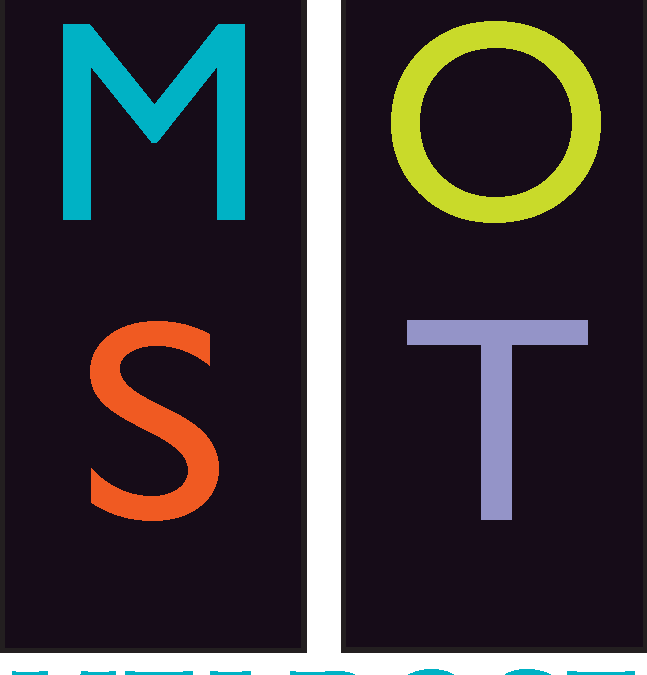
Nov 1, 2017
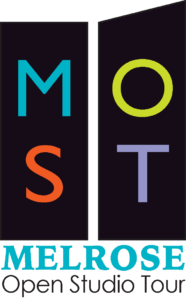 Melrose, Massachusetts (my fair town) has a vibrant art community and festival. We even have a community arts calendar. As a member of the Cultural Council for six years, my appreciation of the reality and possibilities grew. So when Demi Dubois asked me if I thought we could put together an Open Studio Tour in six weeks, it didn’t take for me to respond, “Yes.”
Melrose, Massachusetts (my fair town) has a vibrant art community and festival. We even have a community arts calendar. As a member of the Cultural Council for six years, my appreciation of the reality and possibilities grew. So when Demi Dubois asked me if I thought we could put together an Open Studio Tour in six weeks, it didn’t take for me to respond, “Yes.”
In three weeks, with help from Ellen Rolli and Adrian Johnston, she gathered many artists, a logo so I’m whipping together a web site for the first Melrose Open Studio Tour.
You heard it here first!
I’m running upstairs to get my fiber den ready for visitors. See you there?
Oct 15, 2017
The 2017 Melrose Art Walk adds extra spice to our pleasant historic downtown. In its 10th year, I’ve always enjoyed seeing works of local artists and appreciate the way our businesses support them. This year, my art quilts are even part of the exhibit! Three quilts are on display at Halo Studio, 467 Main Street. It’s a perfect fit, as Jen Malenchini is one of the first Melrosians we met when we moved here. Jen was working elsewhere in town and we followed her as she opened her own business. Go Jen!
Not knowing where the quilts might be displayed, I focused energy on completing three small works, imagining that I would need to display in a small space. Jen has huge windows and darn, if I had known earlier. Other larger pieces that could have potentially worked were either too long or made of silk (which I really can’t display in a west facing window for a few weeks). So works like “Trees in the Rain” stayed home.
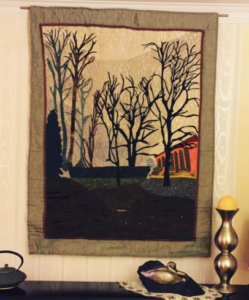
Why look, there’s a sculpture by Ross Matteson with Trees in the Rain
Ross Matteson urged me repeatedly to take photos, which I will, I promise. I think he meant before I put them on display, but um, that didn’t happen.
The three quilts are all based on New England settings and experiences. I think they are nice examples of my art quilt tendencies: hand work, felted wool and dabbling with book making techniques in my quilting. Having said that, I realistically admit that a current quilt is a whole cloth, machine quilted piece.
Am I avoiding the fact that I should take photos before the work heads out the door? Undoubtedly yes.
So imagine my delight when the @MelroseArts Instagram feed reposted @ColorMyWorldCrochet’s post.
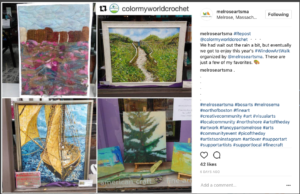
There’s my art quilt in the top left corner! This is from my series, “Boston Women’s March.”
Thank you ColorMyWorldCrochet! And check out her Etsy page… she has very cool slouchy beanies and stylish hats.
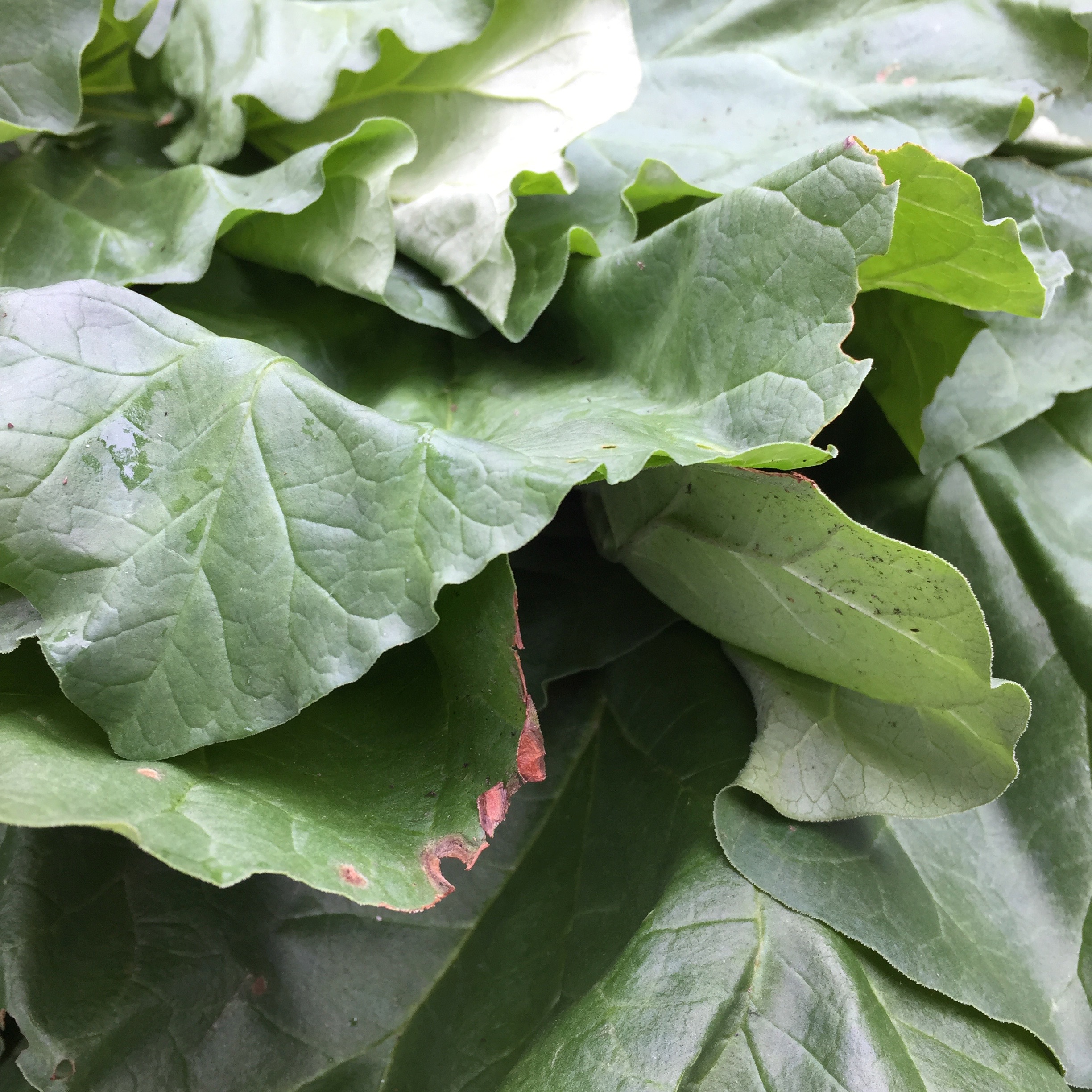
Sep 25, 2017
It is time. Time to stop reading, planting, nurturing and foraging. It’s time to start my journey into natural dyes. My first bite into this aromatic and interesting exploration is to make a mordant from rhubarb leaves.
“What is a mordant,” you ask?
The water based, delightful tonic binds the color to the fiber – chemistry in action. A mordant’s role in dyeing fiber is particularly important as natural dyes tend to fade. If I spend my time on an art quilt, longevity and conservation are paramount. I’ll do what I can to ensure this piece will be around for a long while.
As in many journeys, where would we be without our support network? Thanks to a dear friend who shared 1.5kg of gorgeous rhubarb leaves (and even stalks to eat!).
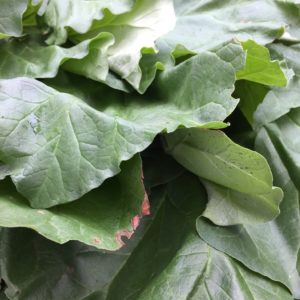
My young rhubarb plant doesn’t have nearly as many beautiful leaves, so I’m grateful for this contribution.
With an enamel pot found at a Savers, my “elixir” topped my camping stove on Saturday night. It’s not exactly singalong or s’more style, but the desired results were attained (or at least, I hope so… wait and see the final results). After simmering for several hours and sitting in the bath all night, I hope this mordant will do the trick.
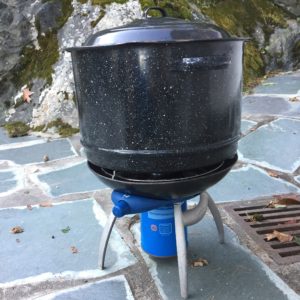
I’m gathering pokeberries and putting them in the freezer to create a dye bath that hopefully will not be too fugitive… using a recipe from Chris MacLaughlin’s A Garden to Dye For: How to Use Plant from the Garden to Create Natural Colors for Fabrics and Fiber.
Next up? Picking up acorns before the squirrels get them all! Wish me merry mordant making.
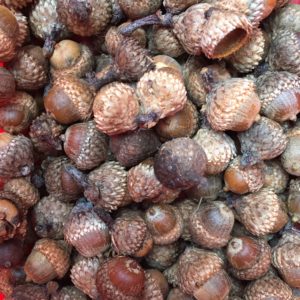



 Melrose, Massachusetts (my fair town) has a vibrant art community and
Melrose, Massachusetts (my fair town) has a vibrant art community and 






